Human Development Index: South Asia
This is a collection of articles archived for the excellence of their content.
|
Sources of this article
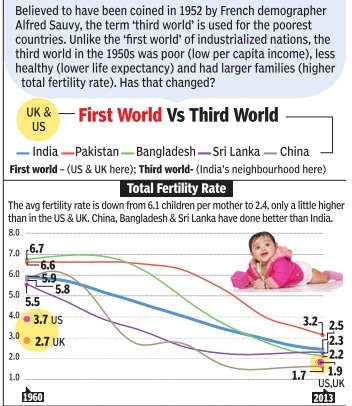
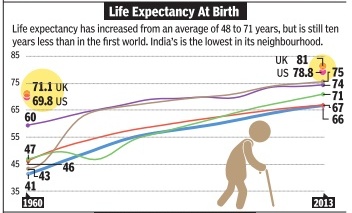
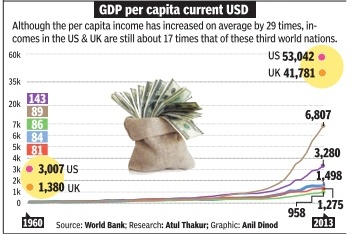
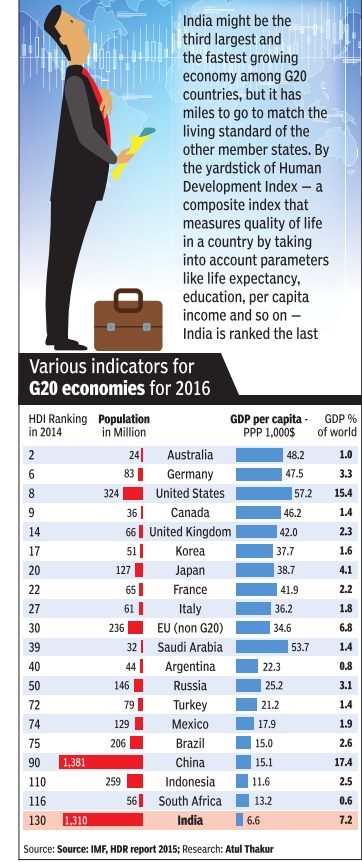
i) HDR.UNDP
ii) Life expectancy in India goes up by 7.9 years since 1990: UNDP report The Times of India TNN | Jul 24, 2014
iii) India ranks 135 in human development index: UNDP TNN | Jul 24, 2014 The Times of India
Countries and HDI ranks in 2013 and change in rank from 2012 to 2013
In the alphabetical order
|
Afghanistan |
169 |
0 |
|
Bangladesh |
142 |
1 |
|
Bhutan |
136 |
0 |
|
India |
135 |
0 |
|
Maldives |
103 |
0 |
|
Myanmar |
150 |
0 |
|
Pakistan |
146 |
0 |
|
Sri Lanka |
73 |
2 |
Listed by HDI rank
|
Sri Lanka |
73 |
2 |
|
Maldives |
103 |
0 |
|
India |
135 |
0 |
|
Bhutan |
136 |
0 |
|
Bangladesh |
142 |
1 |
|
Pakistan |
146 |
0 |
|
Myanmar |
150 |
0 |
|
Afghanistan |
169 |
0 |
South Asian countries in HDR 2014
India’s life expectancy has increased from 58.5 years in 1990 to 66.4 years in 2013.
India's human development index (HDI), a measure of health, education and standard of living, inched up by less than half a per cent between 2012 and 2013, the new Human Development Report 2014 says. While this slow growth is similar to most other countries, it is much below India's growth in the past. Between 1980 and 2013, India's HDI increased by nearly 59%, a yearly growth of about 1.4%. But since 2010, India's growth in human development measures has slowed down considerably.
India is ranked at 135, among the 'medium development' countries like Egypt, South Africa, Mongolia, Philippines and Indonesia. Among India's neighbours, Bhutan and Bangladesh too figure in this category. Pakistan (ranked 146) and Nepal (145) are in the 'low development' category, while Sri Lanka (73) is in the 'high development' category.
The HDR covers 187 countries across the world and is published annually by the United Nations Development Programme (UNDP). In the current report, the top five countries ranked in terms of the HDI are Norway, Australia, Switzerland, Netherlands and the US. The bottom five in this ranking are Niger, Democratic Republic of Congo, Central African Republic, Chad and Sierra Leone.
Citing recent estimates of giving universal basic old age and disability pension, basic childcare benefits universal healthcare, social assistance and 100-day employment guarantee, the report says India would need to spend just about 4% of its GDP to provide all this.
Life expectancy
India's life expectancy has increased from 58.5 years in 1990 to 66.4 years in 2013. While this is a significant increase, both Pakistan and Bangladesh have slightly better life expectancy. Among the BRICS countries, only South Africa has a lower expectancy at 56.9 years, primarily due to the HIV/AIDS epidemic. China's life expectancy is 75.3 years. The average for the whole world is 70.8 years, while among the developed countries with very high human development levels, it is 80.2 years.
Educational indicators
On educational indicators, India performs slightly better with 11.7 expected years of schooling, the same as the average for medium human development countries, of which India is a part. This is a measure of how many years of schooling a child is expected to receive if prevailing enrollment patterns continue. The world average is 12.2 years, while the developed countries average 16.3 years. Among the BRICS countries, India's average is the least. Currently, Indians of 25 years or more have received just 4.4 years of schooling on average, compared to a global average of 7.7 years.
Income
It is on the income measure that India fails dramatically. The annual income per person (measured in purchasing power parity terms) for India is $5,150, slightly more than our neighbors, but lowest among the BRICS countries, and less than half the global average of $13,723. The developed countries' average is way ahead at $40,046.
Inequality
To take into account inequality within a country, HDI 2014 also gives an 'inequality adjusted HDI' (IHDI) for 145 countries for which data was available. India lost about 29% in human development because of inequality. This loss was the most, about 42%, in education. Brazil too has a high loss of 26% due to inequality while Russia loses about 12%. China and South Africa did not have the requisite data for this. The world average for inequality loss is 23%.
Multi-dimensional poverty index (MPI)
Another measure is the multi-dimensional poverty index (MPI), which measures deprivations of families in education, health and standard of living using ten indicators. This gives a better picture of poverty than simply measuring incomes. According to this measure, over 55% of India's population is multi-dimensionally poor, compared to just 3% in Brazil, 6% in China and about 10% in South Africa. HDR 2014, however, has used 2005-06 data for India, which is quite outdated.
Gender inequality
Another measure is the gender inequality index (GII), which reflects inequalities in reproductive health, empowerment and economic activity. India is ranked 127 out of 152 countries in this, the same as Pakistan and lower than Bangladesh (115). Among the BRICS countries, India is the lowest. China is ranked best at 37, due to its very good women's health indicators and high female work participation (64%)
South Asian countries in HDR 2017
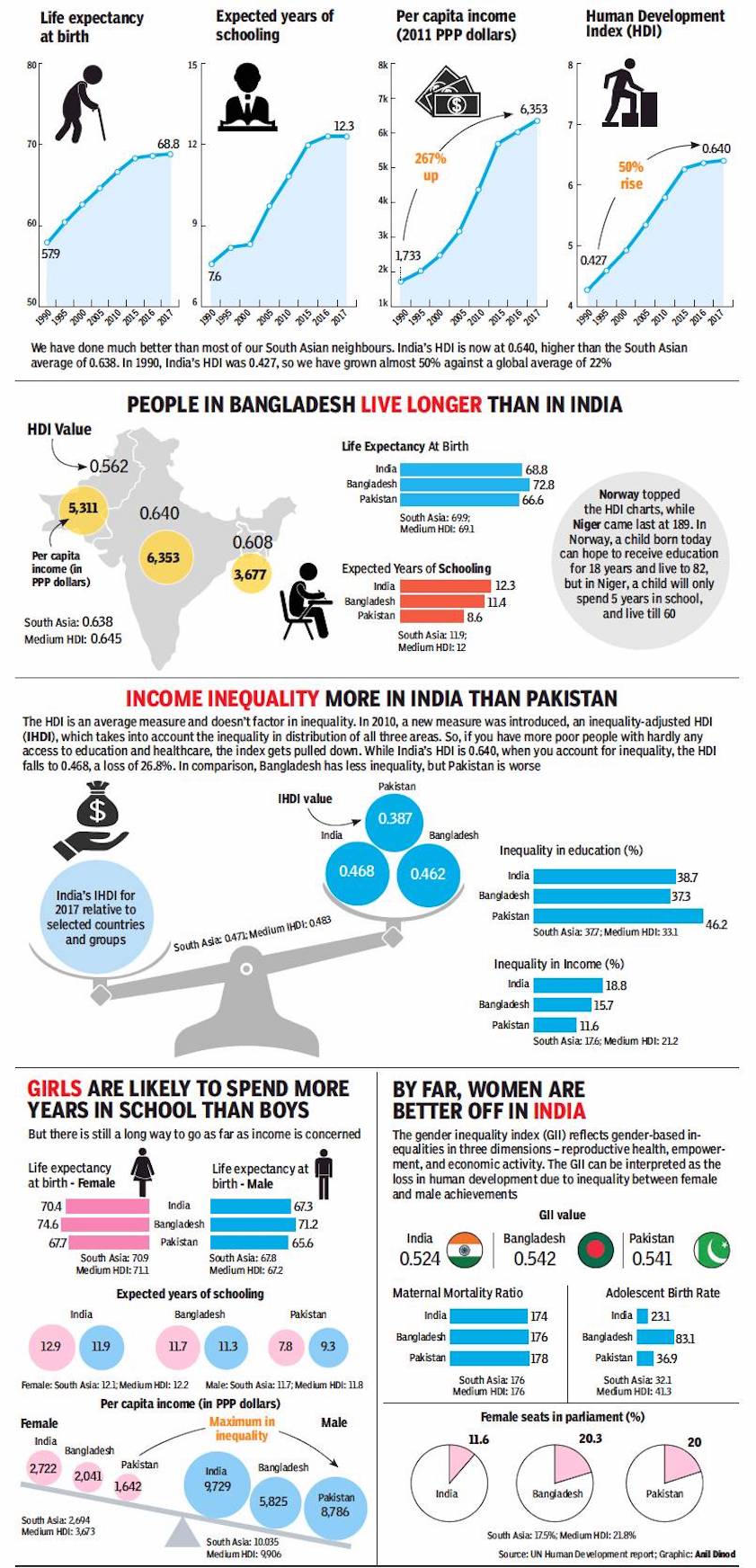
Life expectancy, school education, per capita income, and the Human Development Index
Income (in)equality
Women: Maternal mortality, seats in parliament, girls’ education
From: September 15, 2018: The Times of India
See graphic :
Human Development in Bangladesh, India and Pakistan in 2017
Life expectancy, school education, per capita income, and the Human Development Index
Income (in)equality
Women: Maternal mortality, seats in parliament, girls’ education
India went up one notch in the UN Human Development Index, ranking 130 out of 189 countries surveyed. But if you compare where India stands now with where we were in 1990, we have made massive progress. While Indians had a life expectancy of only 57.9 years in 1990, this has gone up to 68.8 years. Similarly, we are all a lot better off, with a per capita income of $6,353 (in PPP) in 2017 compared with only $1,733 in 1990. That’s a 267% growth
South Asian countries in HDR 2018
India ranks 129, up one spot
Ambika Pandit, Dec 10, 2019 Times of India
India finds itself ranked 129 out of 189 countries in the Human Development Index brought out by the UNDP as part of its Human Development Report 2019. While this is incremental improvement of one point from previous year’s rank of 130, India’s HDI from 1990 to 2018 shows a rise of 50% (0.431 to 0.647) with life expectancy at birth increasing by 11.6 years and Gross National Income per capita increasing by over 262% in this 28 year period. In terms of education, mean years of schooling increased by 3.5 years and expected years of schooling increased by 4.7% in the same period.
The overall HDI value places India above the average (0.634) for countries in the medium human development group and also above the average ( 0.642) for other south Asian countries. HDI has been calculated by assessing long-term progress on three dimensions of human development — a long and healthy life, access to knowledge and a decent standard of living.
However, the challenges are evident in the numbers. While highlighting that India has lifted 271 million out of poverty from 2005-06 to 2015-16, the Human Development Report also draws attention to the fact that 28% of the 1.3 billion multidimensional poor are in India.
Meanwhile, India’s improved HDI is attributed to “nearly three decades of rapid development, which has seen a dramatic reduction in absolute poverty, along with gains in life expectancy, education, and access to health care.” “India’s development initiatives like the Pradhan Mantri Jan Dhan Yojana and Ayushman Bharat are crucial in ensuring that we meet our promise to leave no one behind,” said Shoko Noda, UNDP India Resident Representative.
The report also focuses attention on the next generation of inequalities opening up, particularly around technology and the climate crisis.
South Asian countries in HDR 2019
December 17, 2020: The Times of India

From: December 17, 2020: The Times of India
India ranked 131 out of 189 countries in the UNDP’s Human Development Index (HDI) for 2019, down one step from rank 130 in the previous year. The just released Human Development Report 2020 showed that while India’s HDI score of 0.645 had inched up marginally from 0.642 in 2018, it was still lower than the average for developing countries of 0.689.
The HDI, which completes 30 years, seeks to present a composite measure of where countries stand on three broad fronts — health, education and economic well-being — using life expectancy, expected and mean years of schooling and per capita gross national income as proxies for these three.
In 2019, India ranked 133rd on life expectancy at birth, 125th on expected years of schooling, 162nd on mean years of schooling and 126th on GNI per capita, suggesting that its human development indicators are worse than mere economic factors would warrant.
The data in the report also shows that the improvement in India’s HDI score has been slowing down of late. Between 1990, when the HDI was first compiled, and 2000, India’s score improved by 1.44% a year on average. In the next decade, from 2000 to 2010, it did even better with an annual average improvement of 1.58%. Against this, the average rise of 1.21% a year between 2010 and 2019 was a clear slowdown.
Over the last couple of years, the improvement has been even slower, by 0.3% in 2018 and 0.5% in 2019. While improvements in scores are likely to slow down as the scores increase, India is hardly at a level where that should be happening, still being classified in the “medium human development category”. Norway continues to be at the top of the HDI rankings with Ireland, Switzerland, Hong Kong and Iceland rounding off the top 5. Germany, Sweden, Australia, the Netherlands and Denmark are the others in the top 10, an illustration of the extent to which Western Europe dominates the top of the list.
South Asian countries in HDR 2021
Ambika Pandit, Sep 9, 2022: The Times of India
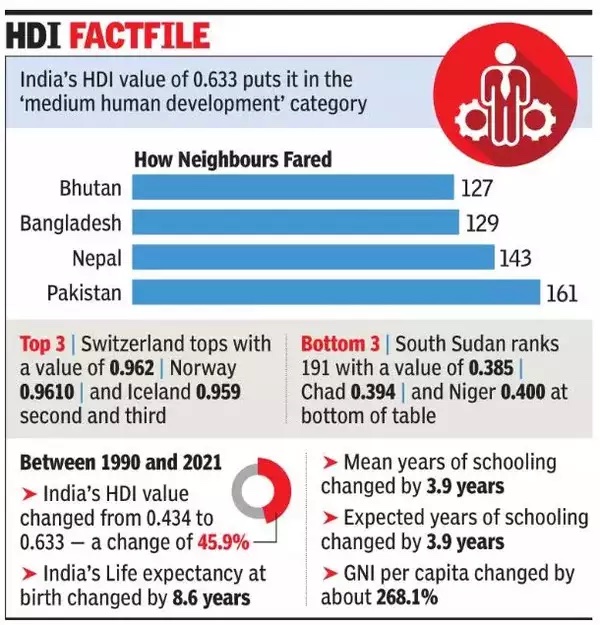
From: Ambika Pandit, Sep 9, 2022: The Times of India
NEW DELHI: As the world emerges from the shadows of the Covid-19 pandemic, India finds itself ranked 132 among 191 countries in the 2021 Human Development Index (HDI) of the UNDP’s Human Development Report. India ranked 130 among 189 countries in the 2020 HDI.
UNDP said it is inaccurate to compare the ranking across countries since in 2020 the HDI was measured for 189 countries, and this year the value has been calculated for 191 countries.
In line with global trends, in India’s case too, the drop in HDI value in the “medium human development” category from 0.645 in 2020 to 0.633 in 2021 can be attributed to falling life expectancy — 69.7 to 67.2 years.
India’s expected years of schooling stands at 11.9 years, and the mean years of schooling are at 6.7 years. The Gross National Income (GNI) per capita level is $6,590. The report shows that 9 out of 10 countries have fallen behind in human development in the face of multiple crises like Covid-19, the war in Ukraine, and dangerous planetary changes. For the first time on record, the global HDI value declined, taking the world back to the time just after the adoption of the 2030 Agenda for Sustainable Development. A large contributor to the HDI’s recent decline is a global drop in life expectancy, down from 72.8 years in 2019 to 71.4 years in 2021.
Meanwhile, the world suffered a 6.7% increase in gender inequality. As far as the Gender Inequality Index is concerned India with a value of 0.490 is placed at rank 122 out of 170 countries.
However, despite the decline in India’s HDI value, it continues to exceed south Asia’s average human development. “India’s HDI value has been steadily catching up to the world average since 1990 — indicating a faster than the global rate of progress in human development,” the UNDP statement emphasised.
HDI is calculated using four indicators – life expectancy at birth, mean years of schooling, expected years of schooling, and the GNI per capita. The latest report shows that progress globally is in reverse. It is highlighted in the report that ‘Human Development’ has declined for two years in a row — 2020 and 2021, reversing five years of progress. This is in line with the global decline, indicating that human development across the world has stalled for the first time in 32 years.
UNDP Resident Representative in India, Shoko Noda however, draws attention to the fact that compared to 2019, the impact of inequality on human development is lower. UNDP’s analysis shows that India is bridging the human development gap between men and women faster than the world.
South Asian countries in HDR 2022
March 15, 2024: The Times of India
India ranks 134 out of 193 in UNDP’s ’22 HDI, a notch higher than in ’21
New Delhi: India ranked at 134 on a list of 193 countries in 2022 as per the latest Human Development Index, a notch higher than 135 out of 192 countries in 2021, attributed mainly to improvement across all HDI indicators over the previous year – increase in life expectancy from 67.2 to 67.7 years, expected years of schooling going up to 12.6 from 12 and per capita gross national income increasing from $6,542 to $6,951, among others, reports Ambika Pandit.
According to UNDP’s Human Development Report 2023-24, India showed progress in reducing gender inequality, ranking 108 out of 166 countries in Gender Inequality Index (GII), as compared with 122 out of 170 nations in 2021. With a GII value of 0.437 in 2022, India fared better than the global average of 0.462 and South Asian average of 0.478.
India’s Gross National Income per capita up 287%: UNDP official
GII measures gender inequalities in three key dimensions — reproductive health, empowerment, and labour market. On GII, the report states that India’s performance in reproductive health is better than other countries in medium human development group or South Asia. India’s adolescent birth rate in 2022 was 16.3 (births per 1,000 women aged 15-19), a marginal improvement from 17.1 in 2021. However, India showed one of the largest gender gaps in labour force participation rate— a 47.8% difference between women (28.3%) and men (76.1%).
However, on Gender Development Index (GDI), India continued to figure among Group 5 countries that have ranked low on eradicating the gap. GDI measures gender gaps on three dimensions — health that is measured by life expectancy at birth; schooling years for adults; and living standards. While life expectancy at birth for females was 69.4 years and that for males was 66.3 years in 2022, but when it came to mean years for schooling, it was 5.5 for females and 7.6 for males. Gross National Income (GNI) per capita for females stood at $2,958 and for males at $10,696.
“India has shown remarkable progress in human development over the years. Since 1990, life expectancy at birth has risen by 9.1 years; expected years of schooling have increased by 4.6 years, and mean years of schooling have grown by 3.8 years. India’s GNI per capita has grown by approximately 287%,” said Caitlin Wiesen, Resident Representative at UNDP India on data on HDI. The report showed that between 1990 and 2022, India saw its HDI value increase by 48.4% (from 0.434 to 0.644).
India’s loss in HDI due to inequality was measured at 31.1%. South Asia’s loss in HDI due to inequality was among the highest in the world (after sub-Saharan Africa), followed by the Pacific. Nepal at 146 and Bhutan at 125 share space with India in ‘medium human development’ category. Pakistan (164) and Afghanistan (182) figure in low human development category. China at 75 and Sri Lanka at 78 figure in the ‘high human development’ category.
South Asian countries in HDR 2023
Ambika Pandit, May 7, 2025: The Times of India
New Delhi: India moved up three places to be ranked 130th among 193 countries in the Human Development Index rankings for 2023 due to progress made in improving life expectancy through health sector initiatives, and sustained improvements in key dimensions of human development, particularly in mean years of schooling and national income per capita.
While noting that India’s progress continues amid global challenges, the 2025 report underscored a broader global slowdown in human development to an unprecedented 35year low, and India is no exception. “Had pre-2020 trends continued, the world would be on track to reach very high human development by 2030, aligning with Sustainable Development Goal timelines,” the report highlighted.
Income and gender disparities in India still significant, says UNDP
Achieving this goal now risks getting delayed by decades, UNDP said. “Inequality between low and very high HDI countries has increased for a fourth consecutive year, reversing long-standing progress,” it added.
UNDP, however, signalled astrong post-pandemic recovery on life expectancy in India, which touched the highest of 72 years in 2023, compared with 58.6 years in 1990. The increase in life expectancy, which rose to 71.7 years in 2022, is among the biggest contributors to India’s improved overall ranking. UNDP also highlighted that national health programmes by successive govts have contributed significantly to improved life expectancy over the years.
With an HDI value of 0.685, while India remains in the “medium human development category” it is moving closer to the threshold for high human development, which calls for a value of more than 0.7. UNDP said that India’s HDI value has increased by over 53% since 1990, growing faster than both the global and South Asian averages. “This progress has been fuelled by economic growth and targeted social protection and welfare programmes,” UNDP said.
It also factored in improvement in income levels in India. “Over the years, India’s progress on economic growth and investments in programmes like MGNREGA, Jan Dhan Yojana, and digital inclusion have contributed to poverty reduction. Importantly, 135 million Indians escaped multidimensional poverty between 2015-16 and 2019-21,” it said.
At the same time, the report also highlighted that inequality reduces India’s HDI by 30.7%, one of the highest losses in South Asia region.
While health and education inequality have reduced, income and gender disparities remained significant. Female labour force participation and political representation lag, though recent steps — such as the constitutional amendment reserving one-third of legislative seats for women — offer promise for transformative change, the report said. Over the last two years, the expected years of schooling remained almost the same at nearly 13, although the mean years of schooling rose 6.9 in 2023 from 6.6 in the previous year. “Children today are expected to stay in school for 13 years on average, up from 8.2 years in 1990. Initiatives like the Right to Education Act, Samagra Shiksha Abhiyan, the National Education Policy 2020 have enhanced outcomes,” UNDP said.